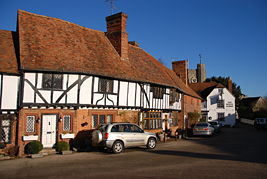Bagham, Kent
| Chilham | |
|---|---|
 Chilham Square |
|
| Chilham shown within Kent | |
| Area | 13.85 km2 (5.35 sq mi) |
| Population | 1,124 (Civil Parish 2011) |
| • Density | 81/km2 (210/sq mi) |
| OS grid reference | TR065536 |
| Civil parish |
|
| District | |
| Shire county | |
| Region | |
| Country | England |
| Sovereign state | United Kingdom |
| Post town | CANTERBURY |
| Postcode district | CT4 |
| Dialling code | 01227 |
| Police | Kent |
| Fire | Kent |
| Ambulance | South East Coast |
| EU Parliament | South East England |
| UK Parliament | |
Chilham is a mostly agricultural village and parish in the English county of Kent with a clustered settlement, Chilham village centre, in the north-east, and a smaller linear settlement, Shottenden. Well preserved roads and mostly residential listed buildings in its centre has led to its use in recorded drama.
The village of Chilham is in the valley of the Great Stour River and beside the A28 road 6 miles (10 km) southwest of Canterbury. It is centred on a market square, where a traditional annual May Day is celebrated. At each end of the square are its major buildings: Chilham Castle and the 15th-century parish church, dedicated to St Mary. It is believed that Thomas Becket was buried in the churchyard. The village has a number of period houses such as the former vicarage, which dates from 1742. The castle was owned by the Viscounts Massereene and Ferrard until its sale in 1997. In 2013 it was owned by Stuart Wheeler, founder of the spread-betting firm IG Index.
The railway station, is in a part of the village sometimes called Bagham on the line from Ashford to Canterbury.
There are two other named localities or neighbourhoods in the civil parish: Shottenden and a much smaller neighbourhood, Old Wives Lees.
There are two large public houses in Chilham, the Woolpack and the White Horse, which dates from the 16th century; in Old Wives Lees there is a further public house The Star. Other amenities include a restaurant and tea shop, post office, gift shop, bus stop, tennis club, sports centre, children's playground and 15th century village hall which originally was the tithe barn for the castle. Most shops are also along the main through road towards Canterbury just before the entry to the network of streets having the oldest buildings in the village.
The Neolithic longbarrow of Julliberrie's Grave is on the Julliberrie Downs east of the river.
...
Wikipedia

